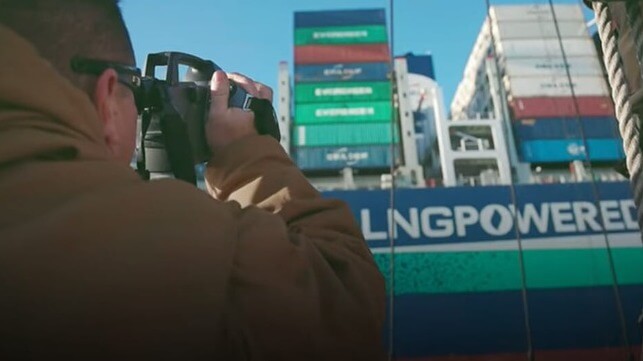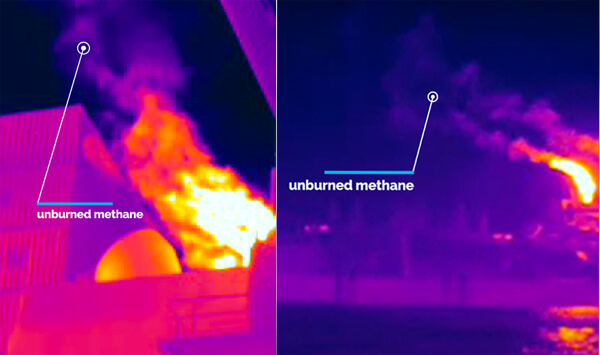NGO Uses Infrared Cameras to Illustrate Methane Slip

Methane slip, the release of unburnt methane into the atmosphere, remains one of the most hotly debated issues in the growing use of LNG for shipping. While the industry argues that significant progress has been made in reducing or eliminating the harmful emissions, a new study from an NGO contends that they have been able to document methane emissions from two in-service vessels.
Using a specially equipped infrared camera, the NGO Transport & Environment reports that it carried out an investigation on a clear November 2021 day at the Port of Rotterdam. They contend that they were able to document significant amounts of methane being released into the atmosphere. They said the effort was limited to two ships due to the complexity of carrying out such an investigation.
“Infrared images show unburned methane being released from supposedly green LNG ships the investigation shows,” T&E wrote releasing its images. They cite data from the International Maritime Organization that says depending on the engine “it has been estimated that between 0.2 percent to over 3 percent of fossil gas slips from the combustion process and is released into the atmosphere.”
According to T&E, the images show heat and gas emissions from the exhaust stack of ship engines. The bright light near the exhaust stack indicates a heat source. As the plume moves away from the heated exhaust stack, they said that they were able to observe uncombusted hydrocarbon emissions. They also had a peer review of the images carried out by TCHD Consulting, an optical gas imaging consultancy, that they report also said that the images are evidence that intense uncombusted hydrocarbon emissions were being released into the atmosphere above the ship. The release did not quantify the level of methane slip that they believe is occurring from the vessels.

T&E says the bright light near the stack indicates heat and as the plume moves away from the stack and cools they observed methane (T&E)
The NGO reported that it observed two vessels in Rotterdam, one being a CMA CGM containership and the other a hopper dredge operating in the Netherlands. The containership was the 23,000 TEU CMA CGM Louvre built two years ago in China as part of the French company’s class of large LNG vessels. The dredge named EcoDelta was built four years ago in the Netherlands.
T&E argues that there is an urgency to address the issues of methane slip because of the increasing number of LNG-fueled ships being ordered. They cited data that shows shipowners commissioned more gas-fueled vessels in 2021 than the four previous years combined. The NGO says its analysis shows that over two-thirds of new ships could be powered with LNG from 2025. “This would raise the share of fossil LNG from an estimated six percent today to over one-fifth of all marine fuels in Europe by 2030 and lock in fossil fuel use into the 2040s.”
Delphine Gozillon, shipping officer at T&E, said, “In promoting LNG ships, European policymakers are locking us into a future of fossil gas. The ships may be painted green, but, beneath the surface, the truth is that most LNG ships on the market today are more damaging for the climate than the fossil ships they’re supposed to replace.”
The LNG industry however cites significant progress with new generations of engines that have reduced or eliminated methane slip. Further, the industry is working to develop bio-methane while researchers are looking at adapting emission scrubbers with new technology to capture methane emissions from a vessel’s exhausts. In March 2022, Japanese shipping and engineer companies reported that they are making significant progress in developing a design to reduce methane slip aboard ships using LNG-fueled engines.
